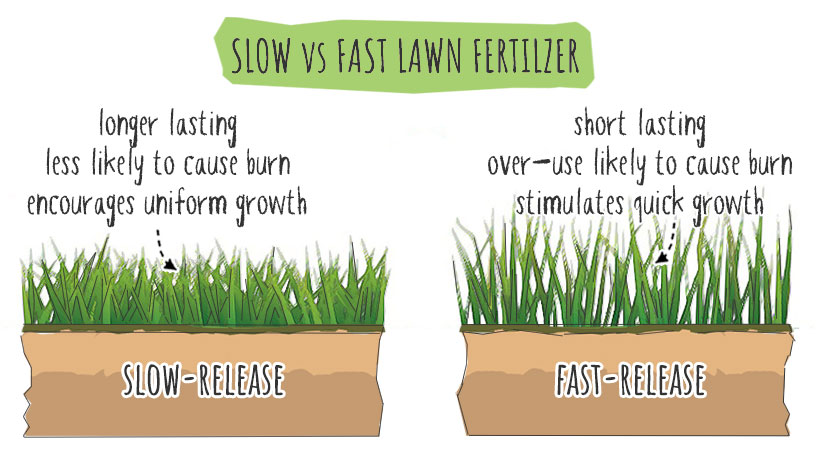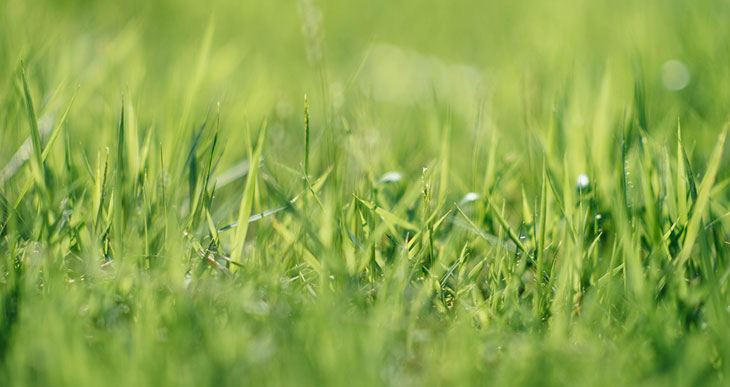How Long Does It Take For Lawn Fertilizer To Work?

Nothing makes a garden look sadder and more run-down than a brown, patchy lawn.
A good solution is to give your lawn some intensive care with fertilizer and a generous amount of water. Sadly, there is no overnight solution, but some fertilizers work surprisingly fast!
There are various types of lawn fertilizers on the market today, and they all work slightly differently. And at different speeds.
Lawn fertilizers broadly fall into two main categories: “quick-release” or “fast-release” fertilizers and “slow-release” varieties.
In this article, I’ll discuss how long it takes for different fertilizers to turn your turf from a bleak, brown mess into a lush, green carpet.
How Long Does Lawn Fertilizer Take To Work?
Fast-release synthetic lawn fertilizers work within 24 to 48 hours after application. Slow-release fertilizers work more slowly, but they are less risky to use. Synthetic slow-release products work in 2 to 5 days, while organic slow-release versions work in 2 to 6 weeks.
Confused Yet?
Let me explain what precisely some of these terms mean…
What Is A Fast-Release Lawn Fertilizer?

Fast-release (AKA quick-release) fertilizers are designed to have an almost immediate impact on grass. The nutrients in these fertilizer products are in a form that is easy for plants’ roots to absorb.
You can get synthetic or organic fast-release fertilizers:
- Synthetic fast-release fertilizers generally contain things like ammonium nitrate, potassium nitrate, calcium nitrate, ammonium sulfate, and potassium phosphate.
- Organic fast-release fertilizers are products like liquid seaweed/kelp, fish emulsions, bat guano, or chicken manure. These are naturally high in nitrogen.
Synthetic and organic quick-release lawn products typically come in liquid form. Because it is a liquid, it quickly penetrates the soil where the grassroots can access the nutrients.
You must dilute the concentrated fertilizer in water and spray it all over the grass. Results are usually visible in under a week. Yay!
However, you must be careful to use the correct quantity of quick-release fertilizer for the size of your lawn. Overdoing it can cause the grass to suffer from fertilizer burn!
What Is A Slow-Release Lawn Fertilizer?
Slow-release (AKA controlled-release) lawn fertilizers are designed to break down gradually and slowly feed nutrients to grass plants. They take a little longer to work, but most experienced gardeners agree they have more lasting results.
Many people prefer slow-release lawn fertilizers over quick-release products because they are far more efficient and less prone to causing fertilizer burn.
Again, you can find both synthetic and organic slow-release fertilizers:
- Synthetic products are usually granular, and each pellet has a protective coating to make it break down more slowly. They contain urea derivatives, like crotonylidene diurea (CDU) and isobutylidenediurea (IBDU).
- Organic slow-release fertilizers contain organic matter from plants or animals, like kelp meal, cottonseed meal, bone meal, blood meal, manure, or worm castings. Compost is also considered an organic slow-release fertilizer.
Slow-release lawn fertilizers are easy to use because they can be broadcast over the grass by hand or with a small fertilizer spreader (I find a hand-powered “whirl” spreader like this is excellent for this job! – Amazon)
Now that we’ve covered the basic definitions of the types of fertilizers, let’s get into the nitty-gritty details.
What timeframes are we really looking at?
And how long does fertilizer take to be absorbed?
How Long Does It Take For Grass Fertilizer To Be Absorbed?
Quick-release grass fertilizers must be applied far more frequently because they are absorbed into the soil more rapidly. It only takes between two to four weeks for quick-release lawn fertilizer to be absorbed completely.
Slow-release fertilizers take much longer to break down, so it takes more time for all the nutrients to be absorbed by the soil and grass plants. It generally takes six to eight weeks, but depending on the product type, it can take even longer to fully absorb.
This is how long it takes for grass fertilizers to be absorbed, but how long does it take to notice the results?
After all… That’s what counts 🙂
How Fast Does Lawn Fertilizer Work?

As mentioned earlier, quick-release lawn fertilizer products are designed to work as soon as you apply them. They immediately release nutrients to grass plants, so they work within a day or two.
Quick-release products are perfect for when you are having an outdoor event and need to give your lawn an instant boost to look aesthetically pleasing. They cause grass leaves to grow very quickly.
Slow-release lawn fertilizers take a little longer to work, but they yield more durable results. After application, you can expect to see results within a week (synthetic products) or within a month (organic products).
Slow-release fertilizers are great for enhancing the overall health of your lawn. They cause the grass leaves and roots to grow more vigorously.
How Long Does Fertilizer Take To Turn My Grass Green?
When grass comes out of dormancy naturally, it takes about two to four weeks to turn green. But if you use lawn fertilizer, you can get it to turn green much faster.
Quick-release grass fertilizers can turn grass greener in as little as a day or two! However, it will take about a week until the grass is evenly green. Slow-release fertilizers take between two and five days to turn grass greener, but they take a few weeks to completely green up the lawn.
Getting fast results is all about choosing the right fertilizer for your lawn. Let’s look at some of the top products for making grass grow fast…
Best Fertilizer To Make Grass Grow Fast
If you are establishing a new lawn and want it to grow nice and fast, you need to feed it a quick-release fertilizer high in phosphorus and nitrogen.
Phosphorus is an essential nutrient for plants’ root growth. Suppose the grass plants can quickly grow deep, robust root systems. In that case, they can take up water and nutrients more efficiently and, therefore, grow faster.
Nitrogen is what plants use to create chlorophyll for photosynthesis. So the better grass can photosynthesize and feed itself, the faster it grows.
Look for products with a high nitrogen content and a balanced amount of phosphorus and potassium. This organic version is a good example (Amazon). Granular formulations like this release some nutrients quickly, providing grass with an instant growth boost but slowly releasing the rest to sustain grass growth for several months.
Quick recommendation: Best Fertilizer To Make Grass Green Fast
Milorganite is a fantastic product for quickly making your grass green (Amazon link). It has an N-P-K ratio of 6-4-0, so it is high in nitrogen and phosphorus, both essential for green grass.
Milorganite is also rich in iron and is said to turn grass “blue-green.” Iron is another critical mineral that plants use to produce chlorophyll. Chlorophyll is, essentially, what makes grass leaves green.
It is made from urban wastewater and is enriched with beneficial microbes. Technically, Milorganite is a slow-release granular fertilizer, but experienced gardeners say it does wonders for turning grass green quickly.


